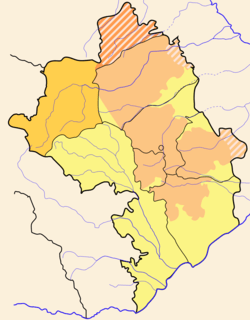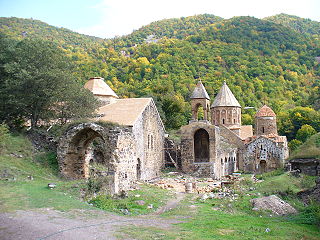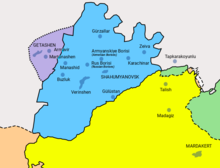Shahumyan Province
Shahumyan Province (Armenian: Շահումյան) is a province of the de facto Republic of Artsakh. The Republic has limited international recognition. It is de jure part of the Republic of Azerbaijan. Only the western part is under the de facto control of the Artsakh Defense Army. The eastern part (original district of Shahumyan), although claimed by the Artsakh Republic, is controlled by Azerbaijan. The southern part of Azerbaijan's Goranboy District along the ceasefire line contains that part of Shahumyan Province which is claimed by the Artsakh Republic. While the claimed part almost wholly lays outside the Nagorno-Karabakh Autonomous Oblast, it nevertheless had mainly Armenian population. Armenian and Artsakh forces failed to capture the eastern part during the Nagorno Karabakh War in 1992.
Shahumyan Շահումյան | |
|---|---|
 | |
| Capital | 1991-1992 — Shahumian from 1993 — Karvachar |
| Government | |
| • Governor | Harut Mnatsakanyan |
| Area | |
| • Total | 1,830 km2 (710 sq mi) |
| Area rank | Ranked 3rd |
| Population (2013) | |
| • Total | 3,521 |
| • Rank | Ranked 8th |
| • Density | 1.9/km2 (5.0/sq mi) |
Shahumian Province has 16 communities of which 1 is considered urban and 16 are rural.
History


In antiquity the territory was a part of Artsakh; in the Middle Ages it was part of the principality of Khachen; in the 17-18th centuries the territory formed part of Melik-Abovian dynasty's melikdom[1] of Gulistan, with its capital in the fortress of that name. During Soviet times in the area was renamed after the Armenian Bolshevik Stepan Shahumyan, its administrative center taking the same name.
By the 1990s the population of Shahumian district was almost exclusively Armenian by language and ethnicity, though the area was not included within the boundaries of the Nagorno-Karabakh Autonomous Oblast by the Soviet Union.
In the spring/summer of 1991, Soviet premier Mikhail Gorbachev ordered Operation Ring[2] in which the Soviet Red Army and Azerbaijani OMON surrounded some of the area's Armenian villages (notably Getashen and Martunashen) and violently deported their inhabitants to Armenia.
Approximately 17,000 Armenians living in Shahumian's twenty-three villages were deported out of the region.[3]
In December 1991 with the Soviet Union imploding, Shahumian was claimed by the Nagorno-Karabakh Republic and became the focus of considerable fighting. This reached a climax in summer 1992 when most of the area was retaken by the Azerbaijan army. Damage was severe and the Armenian population fled.
The historical name of the town of Shahumian was abolished and renamed to Aşağı Ağcakənd in 1992 and it has been partly re-populated by ethnic Azerbaijanis, some of whom are refugees.[4]
During Operation Ring, Soviet forces acting in conjunction with the local Azerbaijani OMON forcibly deported Armenians living in the villages of the region of Shahumyan.[5] The operation involved the use of ground troops, military, armored vehicles and artillery.[6] The deportations of the Armenian civilians were carried out with gross human rights violations documented by international human rights organizations.[7][8][9]
External links
References
- Raffi. Melikdoms of Khamsa.
- Karabagh Massacres Chronicle
- Melkonian. My Brother's Road, p. 186
- Trailblazer "Azerbaijan with Excursions to Georgia", Hindhead, UK, 2004; p245
- Mutalibov stated in this regard, "Я помню, как мы в свое время с помощью русских смогли очистить от армян около 30 сел вокруг Гянджи... Мы были близки даже к освобождению всего Карабаха, но внутренние распри, разногласия, междоусобицы свели на нет наши старания" (I remember how we with the help of Russians managed to cleanse from Armenians 30 villages around Gyandja… we were even close to the liberation of the whole Karabakh but our inner disagreements diminished our efforts). 1news.az 18 Nov. 2008 Аяз Муталибов: "Если мы с Москвой будем говорить четко, я думаю, мы сможем завоевать ее расположение по Карабахской проблеме"
- Croissant. The Armenia-Azerbaijan Conflict, p. 41.
- Human Rights Watch. Bloodshed in the Caucucasus. Escalation of the armed conflict in Nagorno-Karabakh. 1992 p. 9
- Report by Professor Richard Wilson "On the Visit to the Armenian-Azerbaijani Border, May 25–29, 1991" Presented to the First International Sakharov Conference on Physics, Lebedev Institute, Moscow on May 31, 1991.
- "Отчет Дж. Томаса Бертранда о поездке в село Атерк Мардакертского района Нагорного Карабаха - KarabakhRecords". karabakhrecords.info. Archived from the original on 2013-09-21.